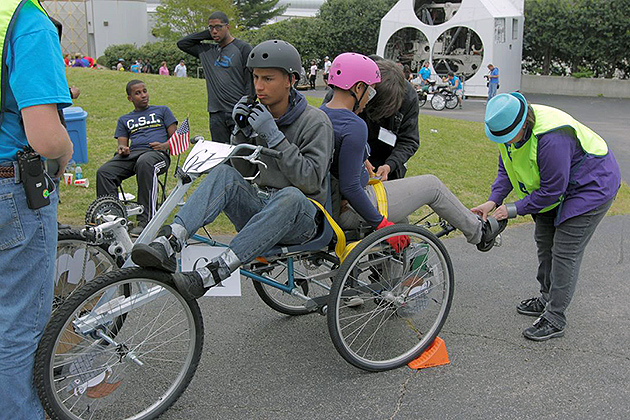
Six students from Hartford’s Academy of Engineering and Green Technology recently competed in the 20th annual NASA Great Moonbuggy Race at the U.S. Space and Rocket Center, with the help of the UConn GK-12 program (Graduate STEM Fellows in K-12 Education).
These young people, who for the most part had never been outside the Hartford area, traveled to Huntsville, Ala. for the three-day event April 25-27, which included racing a vehicle they built on a 0.7-mile course over simulated lunar terrain. The course – scattered with craters, inclines, rocks, and ridges – wound its way around actual spacecraft from past NASA missions.
The Great Moonbuggy Race
The students were charged with designing a human-powered vehicle that addressed many of the same challenges faced by the team of NASA engineers who designed the original Lunar Roving Vehicle. Each moonbuggy had to meet specific criteria. For example, it had to have two drivers, one male and one female, and it had to fold into a 4-foot x 4-foot x 4-foot cube.
“That was one of the biggest challenges we had,” said Juan Pablo Correa, the team’s UConn student advisor. A graduate student in environmental engineering, Correa has been working with the Academy of Engineering and Green Technology group all year long as a Fellow with the GK-12 program, which is funded by the National Science Foundation.
The two drivers had to carry their folded vehicle 20 feet to the starting line and “assemble” it. They were allowed to complete the course twice. The shortest time was combined with the assembly time for the team’s final score.
The Great Moonbuggy Race has two divisions, high school and college. The Hartford team competed with nearly 100 teams from around the country and from as far away as Germany, Russia, and India. They may not have been among the top finishers, but they were winners anyway.
Learning about engineering … and about themselves
“They got a lot out of it,” says team advisor Tom Scheuermann, an engineering and physics teacher at the Academy. He notes that they learned about teamwork, trial and error, and the engineering design process.
Maybe even more important, they discovered something about themselves: Says senior Gvanti Haskins: “You can accomplish anything with a little determination and hard work.”
But although taking part in the NASA event was a great experience, says Correa, it was not without its challenges. Because it was their first year, the Hartford students were up against teams with much more experience. The winning team, for instance, has competed for a decade, continually upgrading and improving their previous buggy.
Correa notes that his students built their vehicle from scratch from the cheapest recycled materials. “They did it all themselves,” he says. “I just guided them.”
Len Beman, a social studies teacher at the Academy of Engineering and Green Technology, who chaperoned the trip to Alabama, says the students learned a lot about overcoming adversity. They had some problems with their vehicle and had to rebuild about 50 percent of it, he recalls.
In inner-city schools, there can be a kind of “learned helplessness,” says Beman. Kids often give up and walk away. But the six-member team worked together to solve their problems. Although they felt like throwing in the towel at times, and very nearly did, in the end they persevered.
Ricardo Santiago, the team leader and the only junior on a team of mostly seniors, fought through those moments of wanting to quit. He is now determined to come back next year and do well in the competition. Correa says that seeing Santiago transformed from discouragement and defeat to excitement about competing again was one of the highlights of the experience.
The inner-city kids also learned another important lesson, according to Beman. “They discovered that people they’ve never met before can care about them.” A college team from Tennessee saw that they were newbies and were having some trouble, so they helped them out. The Hartford team is sending them maple syrup from New England as a thank you.
The biggest challenge: money
Perhaps the greatest challenge the team faced was money. The NSF-funded UConn GK-12 program paid for their vehicle materials, and a grant from the Connecticut Space Consortium funded travel costs for two UConn chaperones. But travel expenses for the students themselves weren’t covered.
Correa did some fundraising, but it wasn’t nearly enough, so he, along with faculty and staff at UConn and AOEGT, chipped in their own money to make up the considerable difference. Next year, they hope to get corporate sponsorship.
Although it was an expensive venture for him, Correa says it was worth it. The trip expanded the horizons of the participants, who had never been outside the Hartford area.
“I enjoyed every second of it,” he says. “They came back from this different people. They’re excited about college.”


